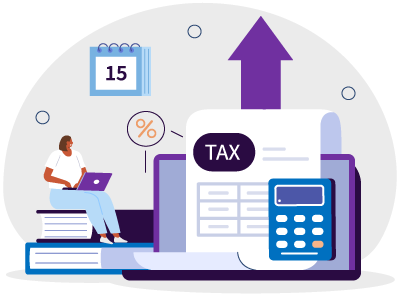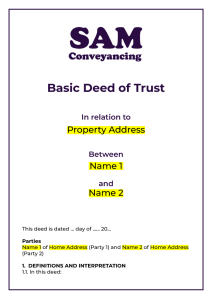Declaration of No Interest in Property
Property ownership isn't always as simple as whose name is on the title deeds. For many, arrangements involving mortgages, family support, or tax planning mean that legal ownership doesn't always reflect who truly benefits financially from a property.
A Declaration of No Interest in property is a legal document that clarifies this difference, confirming that a person listed on the legal title has no beneficial ownership or financial stake.
This means they have no right to income from the property, proceeds from its sale, or any other benefits associated with ownership.
While joint property owners typically share beneficial interests, there are situations where a declaration of no interest is necessary.
For example, during divorce or separation proceedings, a court may order a declaration of no interest to keep both parties on the property's legal title and mortgage for practical reasons (such as maintaining mortgage approval) until a future date, even if one party has no financial stake in the property.
When is a Declaration of No Interest used?
A Declaration of No Interest in property is a versatile legal tool used to clarify beneficial ownership, even when someone's name remains on the legal title.
Stamp Duty Land Tax (SDLT)
A Declaration of No Interest is particularly relevant for Stamp Duty Land Tax (SDLT) planning, especially in situations where multiple people are purchasing a property, but not all of them will have a beneficial ownership stake.
This is crucial in scenarios like Joint Borrower Sole Proprietor (JBSP) mortgages, where parents assist their children with property purchases.
This does mean that the non-proprietor is at risk if the proprietor defaults on payments.
By formally declaring no beneficial interest, the parent (who may already own property) can help ensure their child qualifies for first-time buyer relief or avoids higher rates of SDLT on additional dwellings, as only the beneficial owner's circumstances are considered for SDLT purposes.
Do you need a Declaration of No Interest? Our expert solicitors can help
Our specialist solicitors have experience drafting legally sound and HMRC-compliant declarations of no interest for various purposes, including Stamp Duty Land Tax (SDLT), income tax, and divorce proceedings.
We understand the importance of speed and efficiency, so we aim to have a draft within one to two working days for just £275 INC VAT.
The difference between a legal owner and a beneficial owner
While often held by the same person, these two concepts are distinct, and clarifying them is at the core of this legal document.
Legal Ownership
Legal ownership refers to the individual(s) or entity registered as the owner of the property at the Land Registry. These are the names that appear on the official title deeds.
Legal owners are responsible for the property's administration, such as dealing with mortgages, selling the property, or managing legal formalities. They hold the "bare legal title."
Beneficial Ownership
Beneficial ownership, on the other hand, refers to who truly benefits financially from the property. This includes the right to receive rental income, the proceeds from a sale, or any other financial gains or losses associated with the property. The beneficial owner is the one who has the "equity" or "interest" in the property.
A Declaration of No Interest in Property specifically confirms that someone listed as a legal owner has no right to these benefits, meaning they have no beneficial interest in the property.
This is particularly relevant in situations like a parent being listed as a legal owner on their child's mortgage solely to help them get approved for a loan, without intending to live in the property or receive any income from it.
By signing this declaration, the parent legally confirms they have no beneficial ownership, meaning their financial stake is limited to their role as a guarantor for the mortgage, not as an owner benefiting from the property itself.
If you are planning on transferring beneficial interest to your married partner, these articles are essential reads:
- How to transfer ownership of the house to your wife or spouse
- Stamp Duty on transfer of property between spouses
- Capital Gains Tax on property for married couples
SDLT and Declarations of No Interest
With rising property prices and evolving family structures, it's increasingly common for people to buy property jointly with parents or unmarried partners. However, this can create Stamp Duty Land Tax (SDLT) implications, especially if any of the purchasers already own another property. A Declaration of No Interest is vital in these situations.
The key issue is that if any of the joint purchasers already own or have previously owned another property, they may be subject to higher rates of SDLT or may not qualify for first-time buyer relief.
First-Time Buyer Relief and SDLT
HMRC rules state that to qualify for first-time buyer relief, all purchasers must genuinely be first-time buyers. This means that if even one legal purchaser has previously owned a property, the relief cannot be claimed.
However, a declaration of no interest can be used in Joint Borrower Sole Proprietor (JBSP) mortgages to ensure that parents (who may already own property and are only on the mortgage for affordability) do not count as beneficial owners for SDLT purposes.
This allows the child, if they are a genuine first-time buyer and the sole beneficial owner, to claim the relief. The declaration provides the necessary evidence to HMRC that the parent has no beneficial interest.
Example: John and his parents are buying a house. John will live in the house and be the sole beneficial owner, but his parents are helping with the mortgage. By signing a declaration of no interest, his parents confirm they have no beneficial ownership stake, which may allow John to claim first-time buyer relief (if applicable) and avoid higher SDLT rates.
Higher Rates for Additional Dwellings
If any of the joint purchasers already own another residential property, they will be liable for the higher rates of SDLT (an additional 3% surcharge on top of the standard rates). This increases the cost of buying an investment property or a second home.
However, if one of the legal purchasers is only helping with the mortgage and has no beneficial interest in the property, a declaration of no interest can prevent these higher rates from applying.
This is particularly useful where joint purchasers aren't looking to benefit financially from the transaction, but rather to help their child or partner get onto the property ladder by leveraging their joint salaries for the mortgage.
HMRC guidance (SDLTM09764) confirms this, stating that a purchaser with absolutely no beneficial interest will not be treated as a joint purchaser for SDLT purposes, provided this is evidenced in writing through a declaration of trust within a Deed of Trust or a Declaration of No Interest.
Protect your interest in a property and confirm how to sell. Drafted by a solicitor.
The first draft is within 1 to 2 working days* and includes:
- Deposit paid.
- The percentage ownership of each party.
- How to share expenses like the mortgage and bills.
- Share of property income - rent or gain on sale.
- How to sell the property.
- How the property is divided in the event of separation, divorce, or death.
Andrew started his career in 2000 working within conveyancing solicitor firms and grew hands-on knowledge of a wide variety of conveyancing challenges and solutions. After helping in excess of 50,000 clients in his career, he uses all this experience within his article writing for SAM, mainstream media and his self published book How to Buy a House Without Killing Anyone.
Caragh is an excellent writer and copy editor of books, news articles and editorials. She has written extensively for SAM for a variety of conveyancing, survey, property law and mortgage-related articles.










